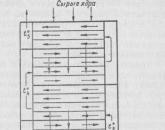What does the personnel officer lead in 1s. Personnel accounting and its proper maintenance at the enterprise
Software "1C: Payroll and personnel management" is a powerful tool for carrying out personnel policy organization, as well as automation of various services of the company, starting with the management of line managers, ending with the personnel of accounting workers.
This configuration was developed by programmers as a separate product, the work of which is focused on performing tasks related to personnel accounting of an organization, company or enterprise.
The introduction of the 1C program for personnel accounting can remove a significant part of the burden from an employee, whether it is just a personnel officer, a payroll accountant, a line manager, an HR manager or an entire organization's personnel management service.
Without a doubt, for small enterprises that do not have a powerful staff, such a problem is not so relevant - after all, everything is manually taken into account and considered so wonderfully, but the situation changes dramatically when the state production organization– 100, 200, or 500 people. Supervising such a staff manually is a rather laborious and inefficient task.
What automates 1C Personnel
Using the software "1C: Payroll and personnel management" provides the following features:
Payroll calculation and accounting
With the help of this program, the costs of paying for services and labor are recorded in the cost of production, mutual settlements with employees are carried out, documents are drawn up on actual output, and vacations and sick leave are recorded and paid. In addition, the introduction of "1C: ZUP" into production allows you to keep track of individual and general work schedules, create pay sheets, timesheets, calculate the set of deductions and accruals, prepare payroll statements, and generate other reports.
HR records management
Given software on the basis of "1C" provides maintenance staffing listing different tariff rates, and also helps in the formation of the necessary reporting in accordance with the staffing table, in the preparation of unified printed forms, filling in travel certificates, registration of business trips, formation of business trip orders;
Regulated deductions
Thanks to 1C Salary and personnel management, contributions to social insurance funds, personal income tax are made, as well as the data obtained during work is uploaded directly to the Accounting 8 program;
Personnel analysis
The configuration helps in the formation of official information (position, division, hiring, vacations, official movements, dismissal, business trips), as well as reports on statistics and personnel movement of the enterprise, maintaining military records and compiling the information necessary for the military registration and enlistment office.
Compared to previous versions based on 1C, this configuration is more versatile, safe, stable and functional. This software solution will be productive in work personnel service for planning, in the selection and accounting of production personnel in the work of accounting, for tax accounting and payroll, and, finally, will help the management of the organization in the analysis of personnel performance indicators.
This software meets all requirements Russian legislation and practices of many companies.
The introduction of 1C Personnel automates the solution of such tasks as:
- providing business with reliable personnel - assessment, questioning and selection;
- planning of needs for working personnel;
- management of certifications, competencies of employees;
- productive planning of employment of employees;
- management of financial motivation of personnel;
- calculation and payment of salaries;
- introduction to production of personnel analysis and personnel accounting;
- display of accrued taxes and salaries in the costs of the enterprise;
- calculation of contributions and taxes established by legislative bodies from the wage fund.
The document registers the fact of admission of an employee to the organization under an employment contract.
It can be created in 1C in several ways:
1. Personnel accounting => Personnel accounting =>
2. Directory Employees => Enter document => Employment in the organization. (Fig. 1)
Rice. 1 Entering a document from an employee form
Document "Employment in the organization"(Fig. 2) on the “Employees” tab, the following is indicated:
- list of employed individuals;
- departments and positions where employees are accepted;
- the number of bets taken;
- dates of admission and periods of work, if employees are hired temporarily;
- marked duration probationary period, if he is.

Rice. 2 Recruitment to the organization. Employees
On the "Accruals" tab (Fig. 3):
- employee;
- type of calculation (for example, daily salary, various allowances, etc.);
- indicators for calculation (salary, allowance, etc.).

Rice. 3 Recruitment to the organization. accruals
After the document is posted, data about the employee and his planned accruals are recorded in the 1C system and will be used in the future when calculating wages.
Document "Personnel transfer of the organization" registers in the system the fact that the employee has changed the place of work and / or the amount of remuneration.
In the 1C system, a document can be created in several ways:
1. Personnel accounting => Personnel accounting => Personnel transfer of organizations.
2. Directory Employees => Enter document => Personnel transfer of organizations. (Fig. 4)

Rice. 4 Entering a document from the employee form
In the document "Personnel transfer of the organization" on the tab "Employees" (Fig. 5) indicates:
- list of relocated workers;
- department and position where the employee moves;
- the number of bets taken;
- date of movement;
- the date of return to the "old" place of work, if the employee is temporarily moving.

Rice. 5 Personnel movement. Employees
On the “Accruals” tab (Fig. 6) the following is indicated:
- employee (to change accrual);
- type of calculation;
- action.
"Begin"- starts a new calculation.
"Change"- changes the accrual that the employee already had.
"Stop"– stops the selected accrual.
"Do not change"- the charge remains unchanged;
- indicators for calculation (salary, allowance, etc.)

Rice. 6 Personnel movement. accruals
Document "Personnel transfer of organizations" allows index earnings:
mark the item “Indexation of earnings with a coefficient” => specify the indexation coefficient => “Fill in”.
After the document is posted, data about the employee and his planned accruals are recorded in the system and will be used in the future when calculating wages.
Document "Leaving the organization" registers in the system the fact of termination labor relations with an employee.
A document can be created in several ways:
1. Personnel accounting => Personnel accounting => Employment in the organization.
2. Directory Employees => Enter document => Dismissal from organizations. (Fig. 7)

Rice. 7 Entering a document from an employee form
IN tabular part document is entered (Fig. 8):
- list of dismissed employees;
- date of dismissal;
- article of dismissal;
- grounds for dismissal;
- checkbox "Stop standard deductions";
- compensation options for unused vacation.
1C:Enterprise 8. Salary and personnel management v.3.1. Level 1
This course meets the requirements professional standard"Accountant" (approved by order of the Ministry of Labor and social protection RF dated February 21, 2019 No. 103n).
Any company, regardless of the type of activity, is required to maintain personnel records. If you want to systematize and organize automated qualified personnel records, with the ability to draw up regulated personnel documents, generate reports based on employee data, take the course “1C: Enterprise 8. Salary and personnel management ed. 3.1. Level 1. Personnel accounting.
Course objective: learn how to keep automated personnel records using standard documents programs in new edition 1C Salary and personnel management taking into account recent changes. The course is built on solving a cross-cutting problem, including all kinds of aspects of personnel records management at an enterprise, from hiring to reporting.
In the course of training on practical examples, personnel records management in the program is considered, starting with the settings of the organization's personnel policy, scheduling work and staffing, and ending with the settings of your own report options. Great attention is paid to the competent formation of orders for personnel (hiring, dismissal, transfers, vacations, etc.). The course also discusses the possibilities of the program related to the change in the requirements for accounting for work books (registration of employee applications for labor activity). Reminder to go into action Federal Laws dated December 16, 2019 N 436-FZ and N 439-FZ, which introduce the mandatory formation of information about labor activity in in electronic format("electronic" work book), which will gradually replace the classic work book. Changes take effect from January 1, 2020 and affect both employers and employees.
The course is based on a cross-cutting example. The situation of starting accounting from scratch is considered, that is, starting from filling in the initial information about the organization and compiling the staffing table and ending with the formation of reports on employees and military registration. Throughout the course, typical situations of personnel records are considered (drawing up and changing the staffing table, orders for hiring, dismissal and personnel transfer, sick leave, vacation schedule, vacation orders and transfers of vacations, business trips, etc.).
The course is designed for specialists in charge of personnel records of the organization, technical specialists implementing and maintaining software products 1C:Enterprise 8 system. The course will also be useful for managers of organizations who want to conduct automated workflow for the purposes of personnel records. The course will be of interest to users who want to learn about the differences in the new edition of this software product.
Hiring is such a simple and familiar operation in the program. Most accountants encounter it regularly, but nevertheless, users have questions very often. How to set an advance for an employee, where to specify a salary expense account, how to accept a previously dismissed employee, where to specify standard deductions. All these tasks are solved at the stage of hiring an employee. And we will consider this operation on the most popular program today 1C: Accounting 8, edition 3.
First, let's make the program settings so that we can work with personnel documents. For this, in the section Salary and personnel let's go to Salary settings:

In the window that opens, set the switch for accounting for payments by wages into position In this program, and for accounting of personnel orders - Full personnel accounting:

Now the program is configured for the work we need. To hire a new employee in the section Salary and personnel open the list of employees:

And we press the button Create:

In the top line, enter the last name, first name and patronymic of the new employee. In the event that such a person has already worked for us, the program will inform us about the presence of such a person in the database. individual. If this is the person we need, and not his full namesake, then we give the program the appropriate command:

In this case, all personal data of the employee will be automatically filled in:

The program is smart. Checks the correctness of entering TIN and SNILS. In my case, this information is incorrect and highlighted in red.
After checking, well, or filling in all the data of an individual, we click on the hyperlink Recruit:

In this document, we fill in the unit, position, type of employment, set the salary and advance payment ... .. oops. Those who have not hired employees in the 1C: Accounting 8 program for a long time, ed. 3 is a little surprise.

Why is it now not possible to set the amount of the planned advance payment to the employee at the bottom of the document. How so? Still, it wasn't that long ago. And even on the ITS disk it is written about it. However, the program is changing and developers are constantly improving the functionality of its functionality. Starting from the 51st release, the program has the ability to specify the date of the advance payment for the organization, as well as specify the total amount of the advance for all employees or for each individually. By default, the advance payment is set on the 25th day of the billing month and the general advance payment for all employees is 40% of the salary. You can change this setting if you wish. To do this, go back to the section Salary and personnel, in the salary settings and in the general settings, follow the hyperlink Payroll accounting procedure:

We open the settings and on the very first tab we see the latest innovations: the date of the advance payment and the sign of the advance payment setting - general or individual.

If the amount of the advance is set individually for each employee, then with the appropriate settings, we set the advance in the document Recruitment:

Here, at the bottom of the document, we prescribe the conditions for admission, this information will be printed in the work order:

From the created order, you can print the order and even the employment contract:

After we have completed and closed the document Recruitment in the card of the employee being hired, the data from the order was automatically filled in:

Here we can also specify how we will pay the salary to the employee: in cash, according to a salary project or to a current account:

Depending on what we choose, we will be able to fill in either information about the personal account of the salary project, or bank account details, where, in addition to the bank and account number, you can change the purpose of the payment (of course, you can also change the recipient, but it is hardly necessary do):

Next, in the employee card, we go to the personal income tax calculation settings, i.e. to indicating the status of the taxpayer, entering applications for standard deductions. Also in the newly opened window it is possible to specify for the employee the income from the previous job:

After filling in this information, we proceed to setting up the employee's insurance conditions. By default, all Citizens of the Russian Federation. Disability information is also set here, if necessary:

Well, the last setting is the setting of payroll costs. By default, for all employees of the enterprise, payroll transactions are set in the payroll accounting settings. However, it is often necessary to specify different ways of reflecting salaries for different employees:

That's all. The employee has been hired. We have indicated all the data necessary to account for his salary. I hope that now you will not have any questions about registering an employee for work in the 1C: Accounting 8 program, edition 3.
Thank you for being with us. Join us in social networks and telegrams and you will find out that 1C is SIMPLE!
We are confident in our prices: If you find it cheaper, we'll refund the difference.
If you choose PROF with us today, you for free get:
- the first 3 months of support, training, consultations and updates;
- delivery in Moscow and regions;
- installation.
1C programs for personnel accounting and payroll:
Program 1C Personnel 8.3 and 8.2 is an effective and unique tool that is intended for integrated automation and maintaining personnel records in municipal institutions that are on an independent balance sheet, financed from the federal or regional budget, as well as the state off-budget fund. Using the program allows you to optimize the following tasks:
- automation of personnel office work;
- recruitment;
- personnel analysis and personnel accounting.
Personnel accounting in 1C 8.3
The 1C Personnel program allows you to store not only personal data about employees, but also up-to-date service information. The latter includes the position, the name of the department, office phones and other contacts. The software module records the promotion of an employee in the organization: starting with hiring, moving, vacations, business trips and ending with dismissal.
Personnel accounting in 1C 8.3 allows you to use the accumulated information to compile a variety of reports. Statistics and movement of personnel, as well as the list of employees of the institution - these are just some of them. If necessary, you can use arbitrary grouping of positions in the organization when generating reports.
Recruitment automation
1C Personnel is able to automate the process of assessing applicants and their selection for vacant position. Its capabilities allow:
- store personal information about candidates;
- store all materials related to the process of working with a candidate: from submitting a resume to the analysis of the results of the survey;
- schedule meetings with prospective candidates and promptly record decisions made;
- maintain a database of questions for questionnaires, which makes it possible to speed up and optimize the process of questioning and processing the results.
The main differences between versions 1C 7.7 and 8.3
- program 1 C Personnel version 8.3 has more advanced functionality that allows you to implement all the main forms for labor accounting: T-10, T-7, T-10a;
- in version 8.3, it is possible to maintain an archive of information transferred to the FIU. At any time after the transfer of information, you can create a request in the program, and personal data and information about the length of service of employees are not used for this;
- For maximum convenience, in version 8.3, the list of tasks that can be performed by analyzing those entered into the database has been expanded. If necessary, you can turn on a reminder about the upcoming birthday of an employee or a previously planned personnel transfer, vacation or business trip.
Popular
- Where to get start-up capital for a business
- How to name a company: examples of names
- Making money in Sims
- How to make money while traveling How to make money while traveling
- All profitable business niches
- All profitable business niches
- Top bucks that pay in dollars
- Earning on comments
- Similar to vktarget. Vktarget reviews. How to get more tasks on the VKtarget project - basic recommendations
- How to start earning in the game Farm Neighbors?




